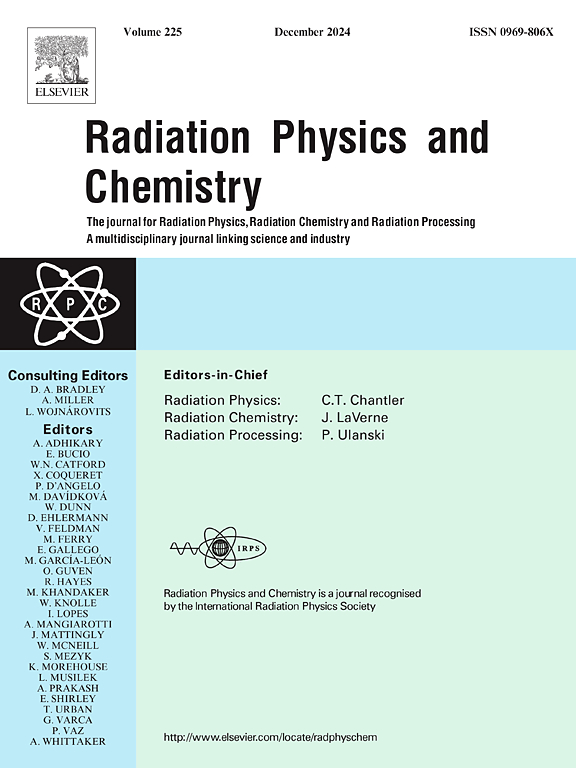Dosimetric analysis of beam number variations in IMRT for head-and-neck, breast, and pelvic cancers using Halcyon
IF 2.8
3区 物理与天体物理
Q3 CHEMISTRY, PHYSICAL
引用次数: 0
Abstract
This study investigated the dosimetric effects of varying beam numbers (9, 11, and 13) in intensity-modulated radiation therapy (IMRT) using the Halcyon linear accelerator at ShingMark University Hospital. IMRT plans for 27 patients with head-and-neck, breast, and pelvic cancers were evaluated according to the RTOG 0615 protocol, focusing on Planning Target Volume (PTV) dose coverage, uniformity, maximum and minimum doses, and Organ-at-Risk (OAR) dose constraints. For breast cancer, the 11-beam plan improved PTV coverage (V50Gy: 97.9 ± 0.5 %) and reduced maximum dose compared to 9- and 13-beam plans, while the 13-beam plan lowered heart mean dose by up to 10.5 % in left breast cases. In pelvic cases, the 13-beam plan enhanced OAR sparing, reducing bowel V35Gy by 10.5 % compared to the 9-beam plan, with minimal PTV coverage differences (<0.2 %). For head-and-neck cancer, the 13-beam plan improved PTV D95 % and spared critical structures like the brainstem, though it increased doses to the chiasm and cochlea. Treatment time and Monitor Units rose with more beams, particularly for head-and-neck and pelvic cases, but remained minimal for breast cases. These findings suggest tailoring beam numbers to cancer type and clinical priorities, balancing dosimetric benefits with treatment efficiency.使用Halcyon对头颈部、乳腺癌和盆腔癌进行IMRT的束数变化进行剂量学分析
本研究利用ShingMark大学医院的Halcyon直线加速器研究了不同光束数(9、11和13)在调强放射治疗(IMRT)中的剂量学效应。根据RTOG 0615方案对27例头颈、乳腺癌和盆腔癌患者的IMRT计划进行评估,重点关注计划靶体积(PTV)剂量覆盖、均匀性、最大和最小剂量以及器官风险(OAR)剂量限制。对于乳腺癌,与9束和13束计划相比,11束计划提高了PTV覆盖率(V50Gy: 97.9%±0.5%),降低了最大剂量,而13束计划使左乳病例的心脏平均剂量降低了10.5%。在盆腔病例中,13束计划增强了OAR保留,与9束计划相比,减少了10.5%的肠V35Gy, PTV覆盖差异最小(0.2%)。对于头颈癌,13束计划改善了95%的PTV D95,并保留了脑干等关键结构,尽管它增加了对交叉和耳蜗的剂量。治疗时间和监测单位随着光束的增加而增加,特别是头颈部和骨盆病例,但乳房病例的治疗时间和监测单位仍然很少。这些发现建议根据癌症类型和临床重点调整光束数量,平衡剂量学效益和治疗效率。
本文章由计算机程序翻译,如有差异,请以英文原文为准。
求助全文
约1分钟内获得全文
求助全文
来源期刊

Radiation Physics and Chemistry
化学-核科学技术
CiteScore
5.60
自引率
17.20%
发文量
574
审稿时长
12 weeks
期刊介绍:
Radiation Physics and Chemistry is a multidisciplinary journal that provides a medium for publication of substantial and original papers, reviews, and short communications which focus on research and developments involving ionizing radiation in radiation physics, radiation chemistry and radiation processing.
The journal aims to publish papers with significance to an international audience, containing substantial novelty and scientific impact. The Editors reserve the rights to reject, with or without external review, papers that do not meet these criteria. This could include papers that are very similar to previous publications, only with changed target substrates, employed materials, analyzed sites and experimental methods, report results without presenting new insights and/or hypothesis testing, or do not focus on the radiation effects.
 求助内容:
求助内容: 应助结果提醒方式:
应助结果提醒方式:


